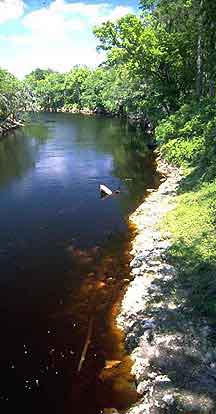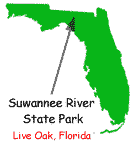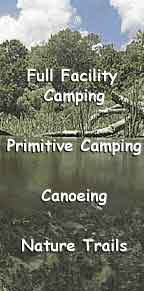| SUWANNEE
RIVER STATE PARK
 The scenic Withlacoochee River joins the historic Suwannee River within
this park. An overlook provides visitors with a panoramic view of the
rivers and surrounding wooded uplands. When the water level is low, springs
may be seen bubbling from the banks of both rivers. The scenic Withlacoochee River joins the historic Suwannee River within
this park. An overlook provides visitors with a panoramic view of the
rivers and surrounding wooded uplands. When the water level is low, springs
may be seen bubbling from the banks of both rivers.
The name "Suwannee"
is thought to have been derived from the American Indian word meaning
"black muddy water." Immortalized in the Stephen Foster song,
"Old Folks at Home," the river is known around the world.
Suwannee River was among the first
parks to become part of the Florida state park system. An original 300 acres
was purchased in 1936. The park now has more than 1,800 acres in three counties:
Suwannee, Madison and Hamilton.
WILDLIFE
Lime Sink Run empties into the Suwannee and flows through weathered limestone
outcrops along much of its course. Beavers are sometimes observed in or
along this peaceful stream. But only by the patient, quiet visitor. The
remoteness of the park provides a haven for an abundance and variety of
wildlife.
HISTORY
The river hums with echoes of history of the booming days of plantations
and logging empires, of the high times of paddle-wheel boats steaming up
and down the river, of the long disorientation after the Civil War and of
the quiet persistence of strong pioneers who lived off this land and profited
from the rivers.
South of the junction of the
rivers, an earthworks (an earthen embankment used as a military fortification)
was constructed by the Confederates during the Civil War. Its main purpose
was to protect the railroad bridge across the Suwannee. Essential supplies,
such as beef, salt and sugar needed to feed the Confederate armies, were
shipped by rail to Georgia. Union troops dispatched from Jacksonville
to capture the bridge were turned back near Olustee in a hard-fought battle
on February 20, 1864. Battle
of Olustee homepage
The town of Columbus stood in
the vicinity of the earthworks. The remains of the Columbus Cemetery, believed
to be one of the oldest cemeteries in Florida, are within the park. Columbus
had its heyday and prospered from its railroad bridge, ferry landing and
a large sawmill. Steamboats were a common sight on the Suwannee and Withlacoochee.
In his memoirs, a Confederate officer recalls standing guard on the bridge
and seeing the elegant house nearby which belonged to George F. Drew, the
operator of the sawmill who became governor in 1876.
FACILITIES
The parks offers many opportunities for recreation in the "Real Florida."
A boat ramp affords easy access
to the Suwannee River.
Picnic tables and grills are standard
at the 31 campsites located in the family campground. Two youth tent camping
areas for use by organized, non-profit youth groups are also available.
CANOE TRAIL
The Suwannee River (upper) Canoe Trail and the  Withlacoochee
River Canoe Trail both begin in Georgia and end in the park. The Suwannee
River (lower) Canoe Trail begins at the park and ends at the Gulf. Withlacoochee
River Canoe Trail both begin in Georgia and end in the park. The Suwannee
River (lower) Canoe Trail begins at the park and ends at the Gulf.
Catches of catfish, bass and
panfish reward the persistent angler. (A Florida freshwater fishing license
is required for persons 16 years of age and older.)
Two picnic pavilions are available
in addition to the individual picnic tables and grills.
NATURE TRAILS
Nature study is easy on the Suwannee River Trail, which winds along the
high banks of the river and along Lime Sink Run. Interpretive labels explain
the hammock and its various plants and animals for those who take the self-guided
tour. The Sandhills Trail takes visitors from the picnic area to the Columbus
Cemetery. The open forest of pines here contrasts with the hardwood hammock
along the river trail. A section of this trail runs along the route of the
old stage road, which ran from Pensacola to Jacksonville and was the major
route of travel in the early 1800s.
All trails are for foot traffic
only! Vehicles and horses are not permitted.

Suwannee River State Park is located 13 miles west of Live Oak, off U.S. 90.
For more information, contact Suwannee River State Park, 20185 County Road
132, Live Oak, Florida 32060; (904) 362-2746.
Suwannee River State Park is
located 13 miles west of Live Oak, off U.S. 90.
Contact:
Suwannee River State Park
20185 C.R. 132
Live Oak, FL 32060
(904) 362-2746
View Larger Map
|





